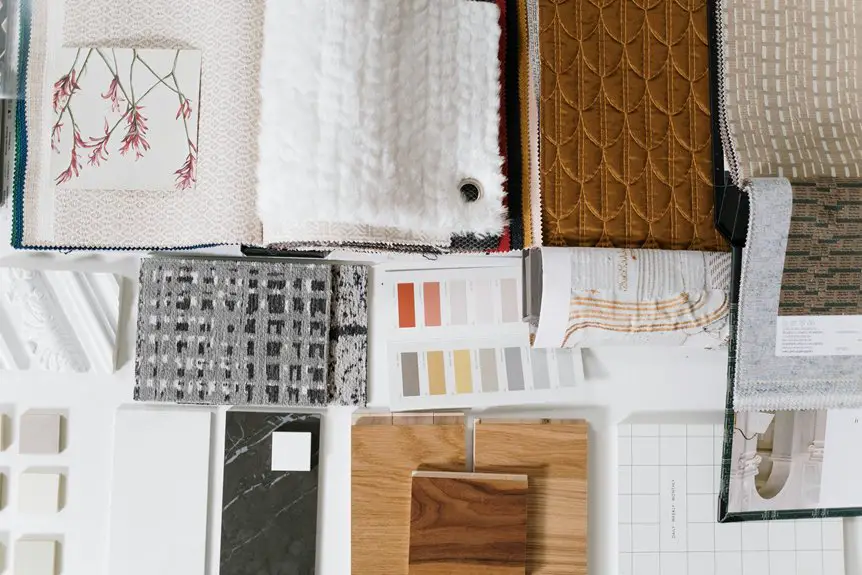Yes, bouclé and velvet go together beautifully when you balance bouclé’s cozy, looped texture with velvet’s smooth, plush feel. To mix them well, choose complementary colors—neutral or muted tones work best—and keep scale in mind to avoid overwhelm. Use bouclé for larger pieces and velvet for accents, like pillows, to add depth without clutter. Careful styling creates warmth and luxury, and as you explore further, you’ll uncover more ways to blend these textures seamlessly.
Table of Contents
Key Takeaways
- Bouclé and velvet complement each other well by contrasting bouclé’s nubby texture with velvet’s smooth, plush surface for visual depth.
- Use neutral or analogous colors to harmonize bouclé and velvet, avoiding color clashes and ensuring cohesive decor.
- Balance large bouclé furniture pieces with smaller velvet accents like pillows or ottomans to prevent overwhelming the space.
- Incorporate metallic accents or subtle patterns to bridge the colors and textures of bouclé and velvet seamlessly.
- Avoid excessive texture mixing and maintain proper fabric care to preserve both bouclé’s durability and velvet’s luxurious appearance.
Understanding the Unique Qualities of Bouclé and Velvet
When you explore bouclé and velvet, you’ll notice how their distinct textures bring different moods to a space.
Bouclé features a looped, nubby surface that adds a tactile, cozy feel, perfect for creating warmth and casual comfort. Velvet, on the other hand, offers a smooth, plush pile that reflects light beautifully, giving your room a sense of luxury and depth.
Bouclé’s cozy texture invites warmth, while velvet’s plush sheen adds luxurious depth to any space.
You’ll find bouclé ideal for laid-back furniture and accent pieces, while velvet works well when you want to introduce elegance and softness.
Both fabrics have durability but differ in maintenance—bouclé hides wear well, whereas velvet needs gentle care to avoid crushing the pile.
Understanding these qualities helps you appreciate how each fabric can contribute uniquely to your decor’s overall texture and atmosphere.
How to Balance Bouclé and Velvet in Your Decor
You can create harmony by choosing colors that complement both bouclé and velvet, ensuring they don’t compete for attention.
Use texture contrast to add depth—pair the nubby surface of bouclé with the smooth richness of velvet.
With the right balance, your space will feel inviting and visually interesting.
Color Coordination Strategies
Balancing bouclé and velvet in your decor requires thoughtful color coordination to create a cohesive and inviting space.
Start by selecting a color palette that complements both fabrics. Neutral tones like cream, taupe, or gray work well, allowing the textures to shine without overwhelming the room.
If you prefer bolder choices, pick one dominant color and use varying shades within that family to unify the look. Avoid clashing hues; instead, aim for harmony by repeating key colors across different elements, such as pillows, rugs, or curtains.
You can also use metallic accents or subtle patterns to bridge the fabrics’ colors without breaking the flow.
Texture Contrast Techniques
Coordinating colors sets the stage, but creating contrast between bouclé and velvet brings your decor to life.
To balance these fabrics, focus on their textures: bouclé’s nubby, looped surface contrasts beautifully with velvet’s smooth, plush finish. Place them side by side to highlight their differences.
For example, pair a velvet sofa with bouclé throw pillows or a bouclé chair with velvet cushions. Vary the scale too—choose larger velvet pieces with smaller bouclé accents to avoid overwhelming your space.
Don’t hesitate to mix warm and cool tones within these textures for added depth.
Choosing Color Palettes That Complement Both Fabrics
When mixing bouclé and velvet, you’ll want to harmonize warm and cool tones to create balance.
Start with neutral shades as your base to keep things grounded.
Then, add accent colors that offer contrast to make both fabrics stand out beautifully.
Harmonizing Warm and Cool
Although warm and cool fabrics might seem at odds, you can create a cohesive look by carefully selecting color palettes that bridge the temperature gap.
When mixing bouclé and velvet, focus on colors that act as a middle ground or complement both tones. Here’s how you can harmonize them:
- Choose Muted Tones: Softened versions of warm and cool colors, like dusty rose or slate blue, blend seamlessly without clashing.
- Use Analogous Colors: Select colors next to each other on the color wheel, such as warm peach paired with coral or cool teal with navy.
- Incorporate Metallic Accents: Gold or silver accessories can unify warm and cool shades by adding a reflective element that ties everything together.
Neutral Shades as Base
Balancing warm and cool fabrics often leads you to contemplate colors that naturally bring harmony, but neutral shades provide a reliable foundation that complements both textures effortlessly.
When mixing bouclé and velvet, choosing neutrals like cream, taupe, or soft gray helps you create a cohesive look without overwhelming the senses. These shades act as a subtle backdrop, allowing the unique textures to shine without clashing.
You can confidently layer these fabrics knowing the neutral palette will unify their distinct appearances. Plus, neutrals make it easier to switch up accent pieces later, giving you flexibility in styling.
Stick with muted tones to maintain balance and let the rich tactile qualities of bouclé and velvet take center stage in your space.
Accent Colors for Contrast
Accent colors can transform your space by adding depth and visual interest to textured fabrics like bouclé and velvet.
When mixing these fabrics, choosing the right accent palette is key to creating harmony and contrast. Here’s how you can pick colors that complement both:
- Bold Jewel Tones: Deep emerald, sapphire, or ruby add richness that enhances bouclé’s softness and velvet’s sheen.
- Warm Earthy Hues: Terracotta, mustard, or burnt sienna bring warmth and tie together the textures naturally.
- Cool Muted Shades: Dusty blues, soft grays, or sage green provide subtle contrast without overpowering the fabrics.
Ideal Rooms and Furniture Pieces for Mixing These Textures
When mixing textured fabrics, choosing the right rooms and furniture pieces can enhance your design effortlessly. Bouclé and velvet work beautifully in cozy, intimate spaces like living rooms, bedrooms, and reading nooks. These areas benefit from the tactile warmth both fabrics provide. Opt for bouclé on larger pieces like sofas or armchairs to add softness, while velvet suits accent pillows or ottomans to introduce rich depth.
| Room Type | Bouclé Furniture Pieces | Velvet Furniture Pieces |
|---|---|---|
| Living Room | Sofa, Armchair | Throw pillows, Ottoman |
| Bedroom | Bed frame, Bench | Headboard, Cushions |
| Reading Nook | Accent chair | Footstool, Throw blanket |
Choosing the right pieces for each room lets you balance texture and comfort while showcasing both fabrics’ unique qualities.
Styling Tips for Layering Bouclé and Velvet
Although mixing bouclé and velvet might seem challenging at first, you can create a stunning layered look by focusing on contrast and cohesion.
Start by balancing the softness of velvet with the nubby texture of bouclé to add depth without overwhelming your space. Here are three tips to assist you in layering these fabrics stylishly:
- Choose a color palette: Stick to complementary or analogous colors to guarantee your layers feel harmonious rather than clashing.
- Play with scale: Use large bouclé pieces like a sofa paired with smaller velvet accents such as cushions or throws for visual interest.
- Mix finishes thoughtfully: Pair matte bouclé with the slight sheen of velvet to highlight each fabric’s unique texture, creating a rich tactile experience.
With these tips, you’ll effortlessly blend bouclé and velvet into a chic, inviting space.
Common Mistakes to Avoid When Combining Textured Fabrics
Since mixing textured fabrics can instantly elevate your decor, it’s essential to avoid common pitfalls that undermine your efforts. One major mistake is overloading a space with too many textures, which creates visual chaos. Also, ignoring color harmony can make your fabrics clash rather than complement. Avoid pairing textures with conflicting scales; large patterns on both fabrics can overwhelm the eye. Neglecting fabric care and durability may lead to quick wear, ruining the look. Finally, don’t forget to balance textures with smooth elements to provide relief.
| Mistake | Why to Avoid It |
|---|---|
| Too many textures | Creates cluttered, chaotic look |
| Clashing colors | Disrupts visual harmony |
| Conflicting scales | Overwhelms the eye |
| Ignoring durability | Leads to quick fabric damage |
| No balance with smooth | Lacks visual rest, feels heavy |
Frequently Asked Questions
Can Bouclé and Velvet Be Used Together in Clothing Fashion?
Mixing bouclé and velvet is like pairing fire and ice—they contrast yet complement beautifully. You can rock both by balancing textures, choosing harmonious colors, and letting one fabric take the spotlight while the other supports quietly.
How Do Bouclé and Velvet Fabrics Hold up to Pet Hair?
You’ll find bouclé tends to trap pet hair more than velvet, which is smoother and easier to clean. Regular brushing and using a lint roller will help keep both fabrics looking fresh despite your pets.
Are Bouclé and Velvet Fabrics Suitable for Outdoor Furniture?
Think of bouclé and velvet as delicate flowers—they’re charming but not built for rain or sun. You shouldn’t use them outdoors unless you want fabric fading and damage. Opt for weather-resistant materials instead.
What Are the Best Cleaning Methods for Mixed Bouclé and Velvet Items?
You should gently vacuum both fabrics regularly and spot clean with a mild detergent. Avoid harsh chemicals or excessive water, and always test a small area first to prevent damage on your mixed bouclé and velvet items.
Can Bouclé and Velvet Be Combined in Bedding and Linens?
They say, “Variety is the spice of life.” You can combine bouclé and velvet in bedding, but balance textures carefully to avoid overwhelming your space. Use bouclé for warmth and velvet for a luxurious, soft touch.
- Does Chiffon Fabric Stink - July 15, 2025
- Does Chiffon Fabric Affect the Economy - July 15, 2025
- Does Cotton Fabric Have a Nap - July 15, 2025







